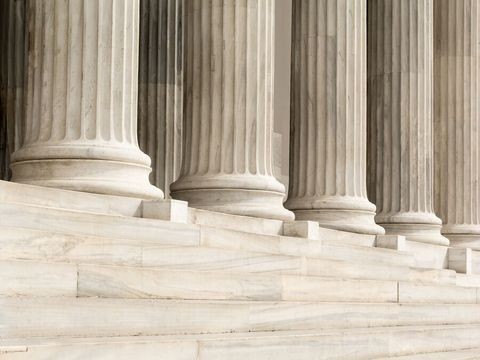DoE’s New Title IX Regulations: What School Administrators Need to Know
Client Alert | 6 min read | 05.13.20
On May 6, 2020, the United States Department of Education issued the final rule setting out new regulations governing institutions’ response to sexual harassment and assault allegations under Title IX. Following their November 2018 release in a proposed rulemaking (NPRM), the much-anticipated regulations, Nondiscrimination on the Basis of Sex in Education Programs or Activities Receiving Federal Financial Assistance, will have the full force of law, unlike prior guidance. The new regulations, issued after the filing of more than 124,000 public comments on the NPRM, require all institutions receiving federal funding to comply by August 14, 2020.
The new regulations impose a number of requirements that will alter significantly the response of many institutions to complaints of sexual harassment on campus, implementation of which no doubt will be extremely challenging in the three months allotted, given the ongoing COVID-19 pandemic. While the Department has drawn criticism for this timing, especially in light of the complex task faced by many institutions in revising their procedures, institutions should not delay moving forward with implementation in hopes that the Secretary, or threatened litigation, will delay their effective date.
Although the unofficial copy of the Final Rule is 2,033 pages long, the following represent several of the most significant requirements:
Live Hearing Requirement and Cross-Examination
Few aspects of the new regulations have drawn more attention than the requirement that postsecondary institutions now must conduct a live Title IX hearing, including the opportunity for cross-examination of all witnesses by each party’s advisor. Institutions that previously utilized a “single-investigator” model to resolve complaints are required to construct a model that separates the investigative function from the decision-making function, with appropriate evidentiary training for adjudicators, and live hearings (which may be “virtual”) that are recorded. Highlighting the importance of cross-examination, the regulations forbid the presiding decision-maker(s) from relying on any statement of any party or witness who refuses to submit to live cross-examination in reaching a determination regarding responsibility. The Final Rule somewhat tailors the scope of cross-examination and questioning by requiring decision-maker(s) to determine whether a question is relevant before the party or witness is required to answer—an on-the-spot, technical, evidentiary ruling difficult even for experienced jurists. The decision-maker(s) must then explain on the record the basis for excluding a question as not relevant. The Final Rule also incorporates some rape shield protections for complainants, as questions and evidence about a complainant’s sexual predisposition or prior sexual behavior are deemed not relevant by default. A school must provide an advisor (of the school’s choice and who may, but need not, be an attorney) to conduct the cross-examination, free of charge to a party if she or he does not have one present at the live hearing.
Scope of Conduct Covered: Definition of “Sexual Harassment”
The Final Rule, like the proposed rule, limits an institution’s Title IX process to “sexual harassment” as defined in the regulations. That definition encompasses conduct that falls into any one of three types of sexual misconduct: 1) quid pro quo, such as where a school employee conditions education benefits on participation in unwelcome sexual conduct; 2) unwelcome conduct so severe, pervasive, and objectively offensive that it effectively denies a person equal access to the school’s education program or activity; or 3) sexual assault as defined in the Clery Act, or dating violence, domestic violence, or stalking as defined in the Violence Against Women Act.
The Final Rule changes the definition of sexual harassment under prior Title IX guidance from conduct that is “severe, persistent, or pervasive” to conduct that is “severe, pervasive and objectively offensive” such that it denies a person equal educational access, incorporating the standard for civil liability and monetary damages set forth in Davis v. Monroe Cty. Bd. of Educ., 526 U.S. 629 (1999). The Rule, unlike the proposed rule, additionally requires that these elements be assessed under an objective “reasonable person” standard. The Final Rule also adopts from civil liability standards the “actual knowledge” prong of the “deliberate indifference” standard, which attributes knowledge – and a duty to act – only when notice of harassment is provided to the institution’s Title IX Coordinator, any official of the institution with authority to institute corrective measures, or to any employee of an elementary or secondary school. Second, the Final Rule clarifies that actionable conduct under the institution’s Title IX processes includes dating violence, domestic violence, and stalking as defined in the Violence Against Women Act, in addition to “sexual assault” under the Clery Act.
However, conduct that does not meet this definition of “sexual harassment” cannot be addressed under the institution’s Title IX process – even if it otherwise satisfies the school’s definition of sexual misconduct. This means that schools may need to develop parallel procedures for addressing sexual misconduct that would violate its own code and/or policies but not constitute “sexual harassment” under the new Title IX regulations.
“Education Program or Activity” Includes Some Off-Campus Locations
The Final Rule also addresses postsecondary institutions’ obligations to respond to reports of sexual harassment that occurred off-campus—another major topic discussed in the public comments. The Title IX statute itself defines “education program or activity” effectively to cover all operations of the school. The Final Rule clarifies that “education program or activity” includes locations, events, or circumstances over which the school exercises substantial control over both the respondent and the context in which the sexual harassment occurs. The Final Rule further extends the scope of “education program or activity” to any building owned or controlled by a student organization that is officially recognized by a postsecondary institution. Notably, this definition extends the reach of Title IX to off-campus fraternity houses not owned by the school. The Final Rule does not, however, extend Title IX protections to students studying abroad, but institutions are not prohibited from addressing or disciplining misconduct via processes outside of Title IX. This is actually a narrowing of the requirements under the prior 2011 and 2014 guidance, which required schools to process all complaints of sexual violence, regardless of where the conduct occurred, to determine whether the conduct occurred in the context of an “education program or activity,” or had continuing effects on campus or in an off-campus education program or activity.
Choice of Evidentiary Standard
The Final Rule also permits schools to continue to use the preponderance of the evidence – or the clear and convincing – standard in Title IX proceedings, so long as the same standard is used to assess responsibility for all allegations of sexual harassment under Title IX, whether the parties are students, faculty, or other employees. Most contracts and collective bargaining agreements with employees require the more stringent clear and convincing evidence standard, so schools may face certain restrictions in choosing which standard to use. Schools should thoroughly consider the implications of each standard given the breadth of their potential applicability.
Mandatory Appeals Process
It is now mandatory for institutions to provide an appeals process as part of their grievance procedures. A school must allow for appeals from both parties on the bases of procedural irregularities that affected the outcome, previously unavailable evidence that could affect the outcome, or conflict of interest or bias by the Title IX Coordinator. Other bases for appeal may be made available if offered to both parties. Additionally, as the school must dismiss conduct alleged in a formal complaint if it does not constitute “sexual harassment” under the new regulations or did not occur within the school’s program or activities, the appellate process must allow for the appeal of such a dismissal.
The aforementioned requirements are by no means the only “new” provisions in the Final Rule. While there likely will be litigation challenging various aspects of the Final Rule and the rulemaking process, based on our years of experience counseling and litigating in this area, absent a court-ordered injunction or other agreement by the Secretary to forestall implementation and enforcement, schools will need to adapt their procedures to reflect the new Title IX reality. Institutions should strive to come into compliance quickly to deter restraining orders or other litigation by respondents or complainants challenging the school’s handling of their cases.
Contacts
Insights
Client Alert | 5 min read | 12.12.25
Eleventh Circuit Hears Argument on False Claims Act Qui Tam Constitutionality
On the morning of December 12, 2025, the Eleventh Circuit heard argument in United States ex rel. Zafirov v. Florida Medical Associates, LLC, et al., No. 24-13581 (11th Cir. 2025). This case concerns the constitutionality of the False Claims Act (FCA) qui tam provisions and a groundbreaking September 2024 opinion in which the United States District Court for the Middle District of Florida held that the FCA’s qui tam provisions were unconstitutional under Article II. See United States ex rel. Zafirov v. Fla. Med. Assocs., LLC, 751 F. Supp. 3d 1293 (M.D. Fla. 2024). That decision, penned by District Judge Kathryn Kimball Mizelle, was the first success story for a legal theory that has been gaining steam ever since Justices Thomas, Barrett, and Kavanaugh indicated they would be willing to consider arguments about the constitutionality of the qui tam provisions in U.S. ex rel. Polansky v. Exec. Health Res., 599 U.S. 419 (2023). In her opinion, Judge Mizelle held (1) qui tam relators are officers of the U.S. who must be appointed under the Appointments Clause; and (2) historical practice treating qui tam and similar relators as less than “officers” for constitutional purposes was not enough to save the qui tam provisions from the fundamental Article II infirmity the court identified. That ruling was appealed and, after full briefing, including by the government and a bevy of amici, the litigants stepped up to the plate this morning for oral argument.
Client Alert | 8 min read | 12.11.25
Director Squires Revamps the Workings of the U.S. Patent Office
Client Alert | 8 min read | 12.10.25
Creativity You Can Use: CJEU Clarifies Copyright for Applied Art
Client Alert | 4 min read | 12.10.25
Federal Court Strikes Down Interior Order Suspending Wind Energy Development





